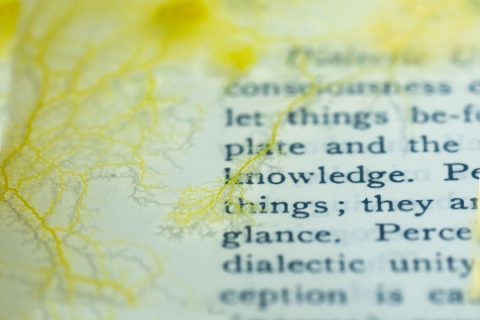The Beall Center for Art + Technology presents an exhibition of human/computer collaborations in poetry

Computational Poetics explores Fluxus-infused work from the 1960s and contemporary experimentation in poetry.
Irvine, Calif., September 23, 2022 — The Beall Center for Art + Technology is pleased to announce the opening of Computational Poetics, co-curated by Hannah B Higgins, computer art scholar at the University of Illinois, Chicago, and David Familian, Artistic Director at Beall Center for Art + Technology. The exhibition opens on Saturday, Oct. 1, 2022, and will run through Friday, Jan. 14, 2023.
In FORTRAN IV, the 1960s programming language of computational poetics (for the purpose of this exhibition), a meaning unit (A) can equal itself (A) plus 1. In other words, instead of fixing meaning, computational poetry already exists, always exists, and is in a state of transformation.
This exhibition surveys human/computer collaborations in poetry, with historical work from the 1960s and contemporary experimentation. From the 1960s to the present, emerging computer and telecommunications technologies have necessitated a fundamental rethinking of language. This half-century includes transitions from mainframe to personal computers, from individual computers to the Internet, from a fleshy conception of the human body to one dominated by lettered genetic code, from western-dominated humanist-based faith in historical progress to a postmodern and postcolonial collapse of ethos with regards to race, class, and gender norms. Each of these technological shifts both generates and responds to cognitive and linguistic mutations. As mutations, these shifts are less random or chance based than one might suppose. Rather, language changes through emerging use.
Language has met the challenge of computation by accelerating, leaping off the page, expressing its embodied nature, abbreviating itself, visualizing, manifesting via sonification and then joining the landscapes of the Anthropocene. Artists and poets play a critical role in this transformation by exploring and exploiting the ever-expanding misalignment between literary and technological culture. These experimental artists and poets directly oppose the authority structure of normative writing associated with the printed word in ways that include (but are not limited to) poetry as read, poetry as expressing raced, gendered and classed models of authorship and expertise, and poetry as disembodied mediation.
No longer content with either the classical tradition of poetry or the standardizing print grids of moveable type, the artists and poets of Computational Poetics first used mainframe computers in the 1960s to explore this space. Not surprisingly, many of the historic poets from the 1960s were associated with John Cage’s Experimental Composition class offered at the New School in 1957-9. Others are part of the intermedia Fluxus group. Subsequent generations of computational poets have expanded these boundaries further by developing and using new processes and computer programs, artificial intelligence, biological materials, emerging ecologies, and the internet. Crucially, these poets (and artist poets) are not simple purveyors of randomized language, as one might suppose. Rather, as co-curators Hannah B Higgins and David Familian understand the exhibition, “‘Chance’ is not random. It is always constrained by situational probability: the number of sticks of the I-Ching, letters of the alphabet, permutations of weather, or organic evolution. It is the uncertainty that is introduced into the work that produces new possibilities, which are further enhanced as each version is generated. Computational Poetics is a mechanism that generates new ways that poetry is understood, what it can be, in a time of uncertainty.”
Some key events of the exhibition: Computational Poetics includes a reconstruction of Fluxus artist Eric Andersen’s long-lost Opus 1966, a piece of computational poetry based on the frequency of words in English that was destroyed around 1970 and remains almost entirely unknown outside Denmark. Computer scientist Henrik Soederstroem has reprogrammed the piece and reintroduced its musical logic in the form of AI-assisted choral performance. Other historic pieces by Jackson Mac Low, Dick Higgins, Alison Knowles and Emmett Williams use computation to explore the algorithmic potential of nature, gun violence, food and habitation, and machines, respectively.
The exhibition also represents a fluid, cross-generational typology of artists and poets challenging normative print culture in the name of experimental poetry by using computers: Cesar & Lois (Cesar Baio and Lucy HG Solomon; Brazil and USA), Christian Bök (Canada), Jon Corbett (Cree, Salteux, Métis), Clint Enns (Canada) (in posthumous collaboration with Nam June Paik (1932-2006; Korea)), Mary Flanagan (USA), Tori Foster (Canada), Tiffany Funk (USA), Kenneth Goldsmith (USA), Rafael Lozano-Hemmer (Mexico/Canada), Allison Parrish (USA), Sasha Stiles (Kalmyk/USA), and Bill Seaman (USA). Here, too, the work is computational in ways that expand algorithmic sensibility into literature, indigenous culture and language, ecology, human reproduction, gender and race.
A public opening reception will take place on Saturday, Oct. 1, 2–5 p.m. Admission is free and open to the public. For additional details on the exhibition, including holiday closures, please visit the website at beallcenter.uci.edu. For visitor protocols related to COVID-19 and up-to-date information, please visit the UCI Forward website at uci.edu/coronavirus.
Computational Poetics is supported by The Andy Warhol Foundation for the Visual Arts and The Beall Family Foundation.
Image: Cesar & Lois, Degenerative Cultures: fire and water, 2022 (project series 2018–2022); Book with Physarum polycephalum (microorganism) growth. Courtesy of the artists.
David Familian, Beall Center Artistic Director
dfamilia@uci.edu
949-824-2189
jdejong@uci.edu
